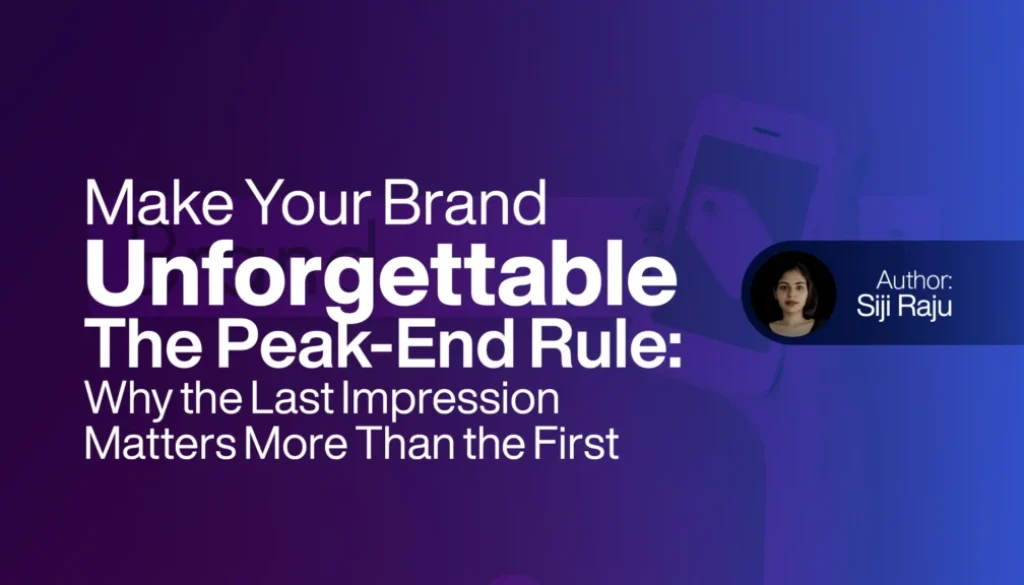Make Your Brand Unforgettable. The Peak-End Rule: Why the Last Impression Matters More Than the First
In the dynamic realm of digital marketing, brands focus heavily on making a great first impression,but what about the last impression? According to the Peak-End Rule, human memory isn’t shaped by an entire experience; rather, we remember the most intense (peak) moment and the final (end) moment. This psychological principle has profound implications for digital marketing strategies, from website experiences to email campaigns and customer service interactions.
Table of Contents
What Is the Peak-End Rule?
The Peak-End Rule is a cognitive bias discovered by psychologists Daniel Kahneman and Barbara Fredrickson. Their research showed that people judge experiences based on two key moments:
- The Peak – The most emotionally intense point (positive or negative) of an experience.
- The End – The final moments of the experience.
Surprisingly, the overall duration of an experience plays a lesser role in how we remember it. This means that even if an experience is long or has ups and downs, people will mostly remember its peak and how it ended.
For marketers, this is a game-changer. It suggests that creating standout moments and ensuring a strong conclusion to an interaction can significantly impact customer perception and brand loyalty.
How the Peak-End Rule Affects Digital Marketing
Understanding how consumers remember experiences allows brands to design marketing strategies that leave lasting positive impressions. Let’s break down how the Peak-End Rule applies to different areas of digital marketing.
1. Website & User Experience
A visitor’s experience on a website isn’t judged by the entire browsing session but by its peak moments and final interactions.
How to Apply the Peak-End Rule:
- Peak Moment: Create a WOW factor—this could be an interactive design, a compelling piece of content, or an AI-powered chatbot that solves a problem instantly.
- End Moment: Ensure a seamless and satisfying final action, such as a smooth checkout process, a delightful “Thank You” page, or a confirmation email that feels personal and rewarding.
Example: A well-designed checkout page with a fun animation or a heartfelt message (“You’re awesome! Your order is on its way ”) leaves a better memory than a generic one.
2. Social Media Marketing
Social media is all about creating shareable moments. Viral content, engaging conversations, and emotionally driven posts serve as peak moments that define how users perceive a brand.
How to Apply the Peak-End Rule:
- Peak Moment: Use emotional storytelling, humor, or surprise elements in content (e.g., behind-the-scenes videos, unexpected giveaways, or heartwarming customer stories).
- End Moment: Close interactions on a high note—whether it’s responding to a comment with enthusiasm or ending a campaign with a powerful call to action.
Example: A brand that runs an Instagram challenge and concludes it with an appreciation post featuring user-generated content will leave a lasting impression.
3. Email Marketing & Customer Communication
Emails often suffer from being overlooked, but applying the Peak-End Rule can make them more memorable.
How to Apply the Peak-End Rule:
- Peak Moment: Use engaging visuals, personalized greetings, or an exclusive offer to capture attention.
- End Moment: Close with a compelling CTA, a thank-you note, or an exclusive surprise (e.g., “P.S. Here’s a special discount just for you!”).
Example: A brand that ends a welcome email with a freebie or discount code creates a positive emotional response, increasing the chances of future engagement.
4. Customer Service & Support
Customer support interactions play a massive role in brand reputation. Even if a customer faces a negative experience, a well-handled resolution can reshape their memory of the brand.
How to Apply the Peak-End Rule:
- Peak Moment: Address customer concerns with speed and empathy.
- End Moment: End on a high note by offering a personalized solution, follow-up, or even a small reward (e.g., a discount for the next purchase).
Example: A brand that quickly resolves an issue and follows up with a friendly email and a discount coupon turns a negative experience into a positive memory.
5. Ad Campaigns & Video Marketing
Consumers remember the most exciting part of an ad (the peak) and how it ends. That’s why commercials with surprise twists or emotional conclusions tend to be the most impactful.
How to Apply the Peak-End Rule:
- Peak Moment: Hook viewers with an emotional story, humor, or an unexpected twist.
- End Moment: Ensure a memorable ending with a strong CTA, uplifting message, or powerful imagery.
Example: A travel brand that starts an ad with an inspiring travel story (peak) and ends with a breathtaking view and an irresistible travel offer (end) will leave a lasting impression.
Conclusion: Why the Last Impression Matters Most
While first impressions are important, the final moments of an experience define long-term memory and brand perception. By strategically crafting peak moments and ending interactions on a high note, brands can create stronger emotional connections, increase customer satisfaction, and enhance brand loyalty.
Key Takeaways:
- Make peak moments stand out – Use emotional storytelling, surprises, or unique experiences.
- End interactions on a high note – Whether it’s a thank-you message, special offer, or warm follow-up, make sure the last impression is positive.
- Apply it across all marketing channels – Websites, emails, ads, social media, and customer service all benefit from the Peak-End Rule.
Author Info
Siji Raju, a Digital Marketer in Thrissur.
Learner of CDA Online Digital Marketing Academy.




